TAKEAWAY: It is weekend, and time to relax and perhaps catch up on our pile of reading that we had no time for during the week. We reminisce about the week that was. ALSO: 40 Years/40 Lessons; Segment 5, Consultant.

I now leave the European continent and travel to the Gulf region for the next ten days, first stopping in Dubai (working with the Gulf News and other publications of the Al Nisr Publishing group) , then continuing to Muscat, Oman, and the Times of Oman. Will attempt to do blog posts updating the media situation in that part of the world, the significant number of SND Awards given to publications in the UAE, and interviews with the editors, designers and artists who make it all happen. Along the way, some sun and sea, for which I am more than ready after a long, never ending winter that has followed me all the way to my home in Florida!
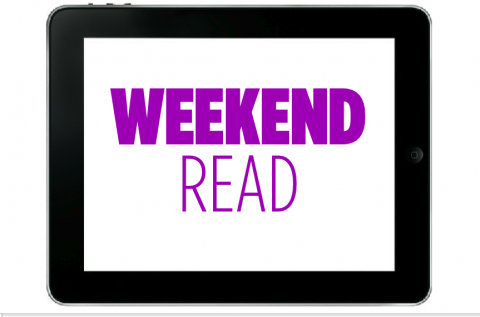
The week that was
As readers of this blog know, we launched the new design for Romania Libera last Monday, with much success and acceptance from readers of that iconic newspaper.Immediately, our friend Robert Bounds, culture editor of Monocle Magazine, asked me to devote my little media column in Monocle to the launch of RL, which I have done gladly, along with some references to Bucharest and the sights, sounds and legends of the city. Hint: Dracula is mentioned!
Highlight of the week and the launch: To see a newsroom that had not seen radical changes for a long time rise to the occasion and produce pages that were as close to perfect as any I have seen in any recent launches.
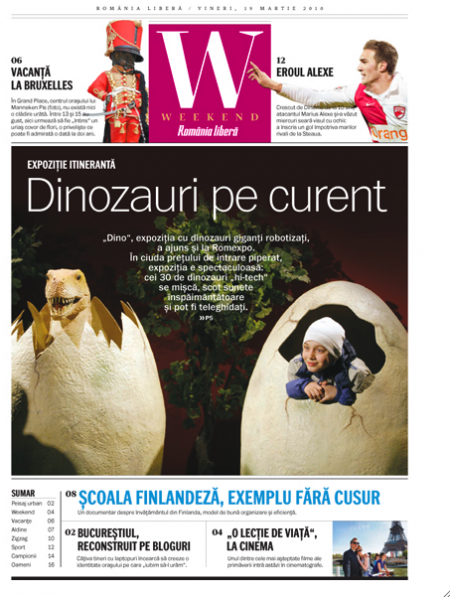
Here is cover of the Weekend supplement of Romania Libera: first day with new look
From Romania I continued on to Brussels, to do a workshop with the talented team of Het Nieuwsblad, the sassy tabloid with the perfect format and the people-oriented coverage. Highlight of this workshop: A good opportunity to remind myself and the group that a newspaper front page must be 60% formula and 40% surprise, and that it is content, the stories selected, and the photo that leads the way visually, that make the difference, more than the design itself (although design can be used to create visual unity in the canvas of that front page).
The week that was in iPad land
This week I mentioned in passing that print people are REALLY excited about the iPad , in a way they never were about online. No surprise?
That comment, which I also used in a Tweet, has generated dozens of emails, some very philosophical, others less so, but all quite fascinating. The majority of those who write me (print people) say that they can see my point about the iPad bringing the sense of order and continuity to a newspaper or magazine’s content that online took away.
This was a discussion during lunch Friday with Paris Match editor in chief, Olivier Royant, and art director, Michel Maiquez. It was delightful conversation and splendid lunch and the talk was how iPad storytelling can take the story several steps higher.
I believe that what the iPad and other tablets will do will be to provide many and longer legs for an editor, his reporter and photographers to expand beyond the surface of the assigned story/photograph.
By the way, simply because it is all about tablets and the much awaited iPad does not mean that printed products are not arriving on the scene as well. Yesterda, the Lagardare group, publishers of Paris Match, launched a new, bright and colorful youngish magazine called Be-—-it is a little Hello, a little Vogue, some Elle, and quite effervesent. Yes, Madonna’s former young Brazilian boyfriend Jesus appears in swimming trunks. My friend Oscar Becerra, whom I always refer to as a magazine creator genius, is behind the product. Good luck.
Have you seen Lula?
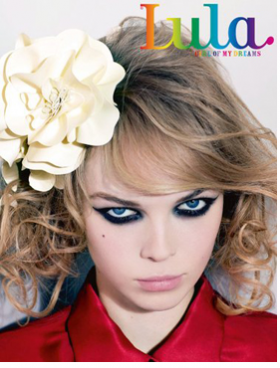
While visiting Michel Maiquez at Paris Match, I discovered this British magazine called Lula, whose catchy phrase is Girl of my Dreams. And that is truly what it is all about, beautiful young models, who could be the girl next door if you add a touch of theatrical make up and probably put a Billie Holliday style flower on her hair. Lula is short on texts and long on photos, but, unlike other contemporary magazines, the design here is set for contemplation and dreaming, nothing nervous about it. Try to get a copy.
iPad chats
As we continue to talk iPad daily in all our meetings, I bring you a couple of links of interest:
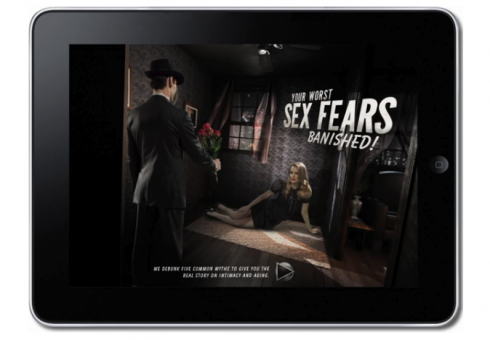
Proposed iPad treatment for the online magazine Viv
Cover and feature piece from an online magazine, Viv, made for the iPad:
http://www.engadget.com/2010/03/18/viv-magazine-ipad-concept-is-sin-city-man/. Quite impressive!
NPR and the WSJ creating iPad versions of their websites that do not use Flash:
http://mediamemo.allthingsd.com/20100315/for-npr-the-ipad-means-a-new-app-and-a-new-web-site/
40 Years/40 Lessons: Consultant
This is part 5 of my occasional series 40 Years/40 Lessons, which I call a “sort of career memoir” capturing highlights and reminiscing about what has been a spectacular journey for me, doing what I love most. Today’s segment: My role as consultant and some tips that continue to help me sail through the sometimes turbulent waters of project development in newsrooms.
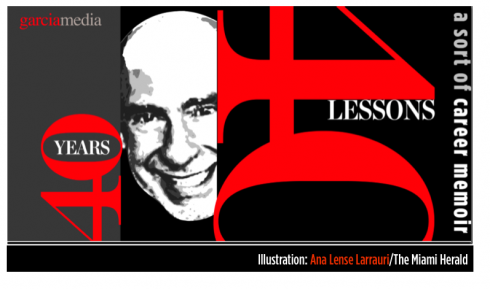

“Consulting is in your future”
I remember my colleague John Zeien telling me that . It was a fall day in 1976 and Zeien, then Director of Student Activities at Miami-Dade College, South Campus, where I was professor of journalism and advisor to publications, had a morning coffee with me and I told him that I had been asked by The Miami Herald to help with some aspects of the design of its incoming Spanish language edition, el Nuevo Herald.
“Well, “said John. “Maybe consulting is in your future and you should pursue it.”
I have to admit that I had never used the word, and did not understand its meaning fully as in “me” becoming a consultant to anyone or anything.
John, the tall man with his ever present pipe, and tons of patience for every student who approached him with a question or problem, had introduced me to the term.
El Nuevo Herald introduced me to the first “consultancy”, light as it was. My role was to see prototypes that had been created internally, and to make recommendations about a possible logo. It was the late Carlos Castañeda, a Cuban jouirnalist who had worked with LIFE Magazine’s Spanish edition in Havana, who created the first look of the newspaper. I came years later, in the late 1980s to do its first redesign, and, again, to play with the logo and its then pink flamingo—-representing tropical Miami. By then I already knew what a consultant was, and had learned to use the term in my correspondence, and when I offered my services.
It was another world
So began a long trajectory from city to city, country to country, continent to continent, one that has not quite ended yet.
As I write this segment, I sit in Bucharest the morning of Monday, March 15, 2010. Today, project #568 in Consultant Mario Garcia’s career saw the light of day.
We have just launched the first edition of the iconic Romania Libera with its new logo, new look, and aiming for a new start, and younger readers. One thing does not change: its desire to continue to chronicle the life of Romanians in a country that is now part of the European Union and dreams big.
Definitions
If one Googles the word consultant these days, hundreds of entries appear, not to mention dozens of books and guides to becoming a consultant. Most will tell you that a consultant helps a firm to improve its performance, to analyze its practices and to change them when necessary, and to provide specialized expertise. The consultant is a coach, an expert, and, the successful ones, game changers.
Indeed, all worthy attributes that those who deserve the title execute to perfection.
What these definitions don’t mention is that the consultant who penetrates into an organization also plays other roles:
Father confessor (the moment you arrive, key players and political animals jockey for position to tell you “their” side of the story. Everyone swears you to secrecy and tells you: I know what I am telling you today will become obvious, but I wanted you to be on alert)
Hand holder: I have no idea why, but many of the execs who hire you are full of insecurities and will expect you to lead them by the hand thorugh the project, coming in to rescue them from time to time by masking their inefficiencies and providing solutions, usually just in the nick of time (like during a presentation).
Validator: What consultant has not realized, early enough in a project, that two or three key people will expect you to present their views, sometimes verbatim, to their superiors. “You see, when you say it , it carries weight, when we do, it goes nowhere,” they all chant in unison. I am always amazed that what they want to sell to their superios makes perfect sense, but, because these people do not pick their battles, and fight for every one, their superios stop listening.
Personnel director: You as a consultant have arrived here to deal with design issues, but soon enough you realize that people are not utilized to their full potential, so you immediately identify talents that should be better utilized. You tell the person supervising this talented individual and usually they are totally surprised that you would single this person out as outstanding. Yes, I am not a management consultant nor a personnel director, but I can tell you that one of the worst crimes committed in the newsrooms of the world is when someone is NOT fired, but is also NOT allowed to advance wtihin the ranks. The person sits there for 20 years, at which time is too late to make major changes, and the talent has been wasted. Worse yet, their morale has gone down so far, that there is no salvation. I have said it many times: worse than being fired is not to be cultivated when you deserve it. The good managers I have met along the way simply tell an employee the following: Listen, you have talents that we cannot use well here, and let the person go. This could be the subject of a full book, and I could illustrate it with examples of dozens of very talented editors and art directors who were simply ignored in their environments, then I came and realized they were perfect for certain jobs.
At moments like that you can spell CONSULTANT with capital letters. Yes, we can add one more item to the unofficial list of what a good consultant does: detective work. Don’t go by the official list of who is who; review the place and make up your own list of who is talented, that usually pays off. Talents are NOT necessarily on a publisher or editor’s top list, and we all know that.
Twice in my career I have had a publisher/editor tell me: you need to find us an art director, we don’t have anyone in house who can do it, only for me to turn around and prove them wrong, while pulling this person out of total anonymity and a boring position, and into the realms of a position where he/she could reveal his talents.
Learning to be a consultant
I had no preparation to turn into a “consultant”.
It was one of those things where I landed in the role of the consultant without much previous preparation. In the baptism by fire rituals that have been such a part of my professional life, I immediately learned a few things that have served me well all along while acting as a consultant:
Here is my list:
1.The consultant is a guest in the house
2.The consultant offers advice, presents options, enhances the dialog, but does not dominate it
3. The consultant becomes a partner in a learning process, not someone who imposes ideas
4. The consultant treats each project as if it was his first, borrowing from previous experiences, but not recreating them at the expense of resting the one project at hand uniqueness.
5. The consultant must pretend that he/she is part of the team, works full time with them, and does not mix one project with the other
The consultant is a guest in the house
My mantra about this issue is simple and to the point. When I enter a building where my services as a consultant have been required, I know that I am a guest in that house. It gives me a sense of boundaries to live by. It helps me to see my role more clearly. It permits me to get the signals when I should simply retrieve to another room. Like guests in a home, consultants must respect the institutional privacy of the clients. When two or three managers begin to have an internal discussion that gets heated in front of me, I do what I would do if I was the guest of a couple who starts a fight in the kitchen during breakfast. I would say: “I think I will have my coffee by the river this morning, to enjoy nature a little bit.” Everyone appreciates that, especially the people in the fight.
Even when the clients in the heated discussion are doing so in a language that I do not understand, I follow body language and I make my retreat pronto.
The consultant offers advice, presents options, enhances the dialog, but does not dominate it
I have been invited to offer advice, to present ideas, to share my experiences in similar projects, but the discussion belongs to the people who own the project, NOT to the consultant. As such, it has always helped me to appear willing to follow the program planned for me by those closest to the project. I do not arrive with agendas, but I do offer them if a request for such appears.
The successful consultant lets the project leader in house run the show, have ownership of the project and allow the leader’s colleagues to see that, indeed, this one is a leader.
My role as a consultant is to become the project leader’s ally, to a point where, by the middle of the project, we are seen as a duo, both of them contributing to the project’s success.
When the consultant dominates every discussion, acts with a know-it-all-attitude and talks more than he listens, usually the people in the room are eventually turned off, and, consequently, the project fails to reach its highest point.
The consultant becomes a partner in a learning process, not someone who imposes ideas
Those who work with me (especially my team at Garcia Media) know this: for me, the best idea wins, regardless of where it came from.
When I work as a consultant, I first impress upon those inside the organization with which I am working than we will have a Sunday brunch of ideas during our discussions and I want the best idea to win.
If a project is full of good ideas, everyone wins.
So, whether we are conducting a briefing at the start of a project, or sketching pages or screens, prototyping a zero number, or getting ready for the introductory marketing campaign, we sit at a table and let every idea land there, like confetti from a huge piñata.
The good consultant—-or should I say, the consultant that is sure of himself—-is ready to abandon his own idea quickly, when presented with one that is superior.
Especially with talented art directors——many of whom I have been blessed to work with—-become your partners. Working together good things happen.. I always want to be surrounded by people who have more talent, experiences and ingenuity than I may have.
When we combine forces, good things happen. The project soars. Everybody wins.
With my own art directors at Garcia Media, when we start sketching a project, I usually start with my own sketches, not because I want to impose them on them, but because, as chief architect of the project, I have assimilated briefings thoroughly and I want to make sure that those first scribbles on paper or screen carry the essence of what the clients have said they want.
However, I am usually prompt to tell my designers: Whatever you do, please complete a version of my sketch ( we call is Version A) then go ahead and do whatever other versions my sketches and briefing inspire you to do.
The result, over more than 560 projects to date: amazingly different styles, divergent ideas that come together to form a unified visual statement. There is no repetition or monotony in what we do, because, although the process is similar (a proven methodology that works each time in terms of systematic work), the creative part is totally different, allowing to serendipity to be ever present in my toolbox.
I remember, while doing the redesign of The Wall Street Journal in 2001, that we often walked around the World Trade Center in Lower Manhattan during the lunch hour. It was summer time, and everyone stepped our from the Wall Street offices to enjoy a bit of lunch in the sunshine.
Everyday we could hear the same music played from the same grinding organ by the same little old man, who, complete with his cart and organ, carried the necessary monkey to add to the entertainment.
You gave the monkey a quarter, and the music would start, again and again.
Obviously, and I am sure many people think so, a consultant could be like the monkey and the organ grinder in the park: give me a quarter and I play the same song, again and again.
Those paying for the services of a consultant don’t want sameness and repetition. They want you to bring a body of work and experience to utilize as you face the specific challenges and problems of one very special client who hired you.
I never forget this.
I do presentations expressly for each client. It was the same in my years as a professor. Every three years or so I would do the summer ritual of emptying all my files of handouts, lectures, slides, etc. Fill plastic bags with the stuff and without thinking twice, put it in the trash.
Then I would pretend, come fall semester, that I was a new teacher, presenting this course for the first time.
Hard work, indeed, but a sense of renewal came with it.
I try to do the same in my consulting work. Recycling is good for the environment, but quite lethal for the consultant.
Not two newsrooms are alike. Amen.
Not two project leaders resemble each other.
The consultant must adapt.
I have consulted for over 560 organizations in 96 countries to date. But it was just after project 40 that I already knew: the stuff that played with gusto in Buenos Aires is not going to get you anywhere in Hamburg, or Istanbul or in Bucharest! In the theater, it was the same, we could be doing the same play five times a week, but each night the audience would react differently to a joke or a bit of business. That is why we adapted the performance to the audience. Boring audiences usually drew boring performances.
It is, I learned many years ago, much better, healthier, more challenging, and, indeed, more fun, to put a blank canvas in front of you that first day you enter the building where a new project awaits.
I still find it thrilling, that feeling of not knowing what you will find.
The consultant must pretend that he/she is part of the team, works full time with them, and does not mix one project with the other
This, some may think, is totally crazy.
It is my way of keeping my wits around me, I guess.
My body moves (the week I am writing this I have done four countries in 7 days), but I follow certain routines.
One of those routines is that when I land in one city, to consult on one project, I make myself believe that I work here full time, that this is a team I am part of, and I don’t remember the project I left 12 hours ago, or the one I am coming to in two days.
If I were to mix projects, cities, countries and languages, I guess I would not be here by now.
The clients know that, and they appreciate it.
I don’t know how other consultants do it, but part of being involved as a full timer means knowing the people more intimately.
I get to know the secretaries, the assistants, the ones who make the coffee, and then, of course, the publisher, editors, designers. I visit some of them at home. I get to know their families.
Long after the projects are finished, those relationships persist.
I often fantasize that I could be stranded in hundreds of cities in over 90 countries and find a place to have a meal and a bed to sleep. Yes, in someone’s house. Of course, I arrived in all those places as a consultant, but today they would greet me as a friend.
It is the perfect evolution when the term “consultant” evolves into the word “friend”.


Forgot to mention that consultants DO lunch.
And do they ever.
A project without a dozen dramatic confessional lunches just does not pack in the goodies.
I have sat thru many, often with a view of the sea somewhere, or staring at a shiny chandelier, or in a mega exclusive club (by membership only), and, while the locale does vary, the sagas that are transacted over chicken salads and a glass of champagne are similar. Normally the person who puts LUNCH on the agenda, has an agenda of his own. You are always part of THREE: the one organizing the lunch brings an ALLY in the newsroom. Two for tea. Two for good alliances. One speaks and whines, the friend validates and eats. The consultant picks at the salad, listens to both side, knowing that tomorrow, the next group comes in, with a different story (and you pray that the venue will change, so at least the menu will be different).
These lunches can be full of tension.
Occasionally somebody cries.
By the time coffee arrives, someone is pleading with you to “do something, since they listen to you.”
Have I heard that plea hundreds of time, in different accents? You bet.
My tip for these drama infused lunches: Eat lightly, consume your full glass of bubblies, listen to all, make no promises,and remember that just like there are at least three ways to serve a Caprese Salad, there is usually more versions of the story that is on your table for this lunch.


1.Mirrors.
https://www.garciamedia.com/blog/articles/40_years_40_lessons_1—a_look_in_the_mirror
2.Refugee.
https://www.garciamedia.com/blog/articles/40_years_40_lessons_2—refugee
3.Teacher..
https://www.garciamedia.com/blog/articles/40_years_40_lessons_3—teacher/
4.Mentors..
https://www.garciamedia.com/blog/articles/40_years_40_lessons_4—mentors/